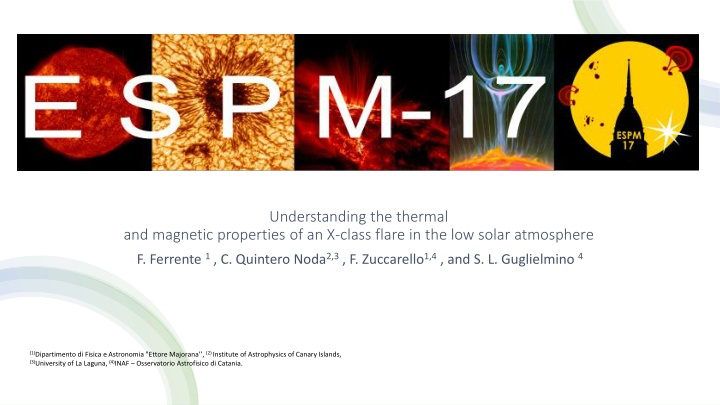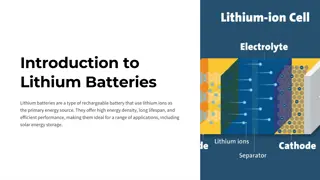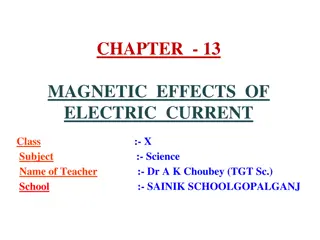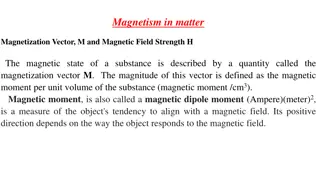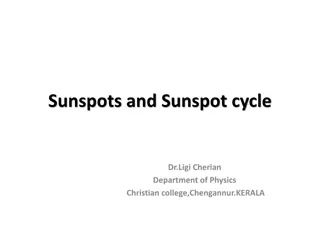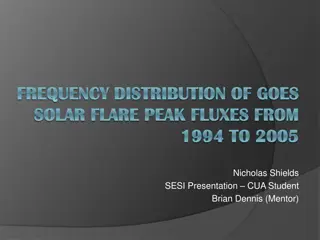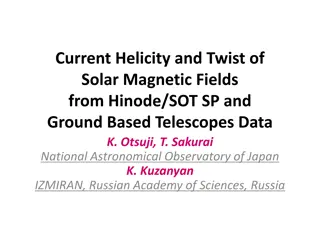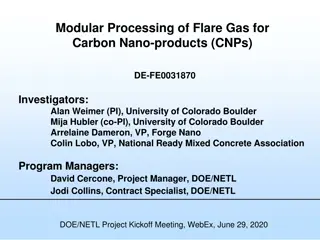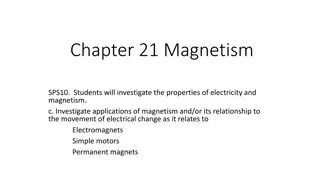Thermal and Magnetic Properties of X-Class Solar Flare
In October 2014, a large active region on the Sun produced several X and M-class flares. This study explores the thermal and magnetic properties of the X-class flare using observations and inversions to analyze temperature, velocity, and field strength variations across different atmospheric depths.
Download Presentation

Please find below an Image/Link to download the presentation.
The content on the website is provided AS IS for your information and personal use only. It may not be sold, licensed, or shared on other websites without obtaining consent from the author.If you encounter any issues during the download, it is possible that the publisher has removed the file from their server.
You are allowed to download the files provided on this website for personal or commercial use, subject to the condition that they are used lawfully. All files are the property of their respective owners.
The content on the website is provided AS IS for your information and personal use only. It may not be sold, licensed, or shared on other websites without obtaining consent from the author.
E N D
Presentation Transcript
Understanding the thermal and magnetic properties of an X-class flare in the low solar atmosphere F. Ferrente 1 , C. Quintero Noda2,3 , F. Zuccarello1,4 , and S. L. Guglielmino 4 (1)Dipartimento di Fisica e Astronomia "Ettore Majorana , (2) Institute of Astrophysics of Canary Islands, (3)University of La Laguna, (4)INAF Osservatorio Astrofisico di Catania.
AR 12192 In October 2014, during Solar Cycle 24, the large and complex active region AR12192 appeared on the east limb of the Sun. It produced 6 X-class and 30 M-class flares. We study in this work the properties of AR12192 using observation obtained by the IBIS instrument at the DST. The blue box shows the Field-of-Viewof IBIS observations.
Spatial distribution of spectral features IBIS recorded the full Stokes vector for the Fe I 617.3 nm and Ca II 854.2 nm. We show the continuum intensity and line core intensity for the Fe I 617.30 nm transition (top row), and Ca II 854.2 nm spectral line (bottom row). 1 pix 0.095 arcsec Full FoV 35x80 arcsec
Spatial distribution of spectral features IBIS recorded the full Stokes vector for the Fe I 617.3 nm and Ca II 854.2 nm. We show the continuum intensity and line core intensity for the Fe I 617.30 nm transition (top row), and Ca II 854.2 nm spectral line (bottom row). 1 pix 0.095 arcsec Full FoV 35x80 arcsec
Inversions result: Accuracy of the profiles We made use of the DeSIRe inversion code for the fitting of the full Stokes spectra of the Fe I and Ca II transitions simultaneously.
Inversions result: Accuracy of the profiles We made use of the DeSIRe inversion code for the fitting of the full Stokes spectra of the Fe I and Ca II transitions simultaneously.
Inversions result: Atmospheres The variation with height of the temperature, LOS velocity, field strength inclination across different optical depths in the solar atmosphere. represent three depths, from left to right, log =[0, 2, 4]. The contour line represents the area of temperature enhancement at log Figure shows the and Columns optical = 4.
Inversions result: Atmospheres The variation with height of the temperature, LOS velocity, field strength inclination across different optical depths in the solar atmosphere. represent three depths, from left to right, log =[0, 2, 4]. The contour line represents the area of temperature enhancement at log Figure shows the and Columns optical = 4.
Inversions result: Atmospheres The variation with height of the temperature, LOS velocity, field strength inclination across different optical depths in the solar atmosphere. represent three depths, from left to right, log =[0, 2, 4]. The contour line represents the area of temperature enhancement at log Figure shows the and Columns optical = 4.
Inversions result: Atmospheres The variation with height of the temperature, LOS velocity, field strength inclination across different optical depths in the solar atmosphere. represent three depths, from left to right, log =[0, 2, 4]. The contour line represents the area of temperature enhancement at log Figure shows the and Columns optical = 4.
Inversions result: Atmospheres The variation with height of the temperature, LOS velocity, field strength inclination across different optical depths in the solar atmosphere. represent three depths, from left to right, log =[0, 2, 4]. The contour line represents the area of temperature enhancement at log Figure shows the and Columns optical = 4.
Inversions result: Atmospheres The variation with height of the temperature, LOS velocity, field strength inclination across different optical depths in the solar atmosphere. represent three depths, from left to right, log =[0, 2, 4]. The contour line represents the area of temperature enhancement at log Figure shows the and Columns optical = 4.
Inversions result: Atmospheres The variation with height of the temperature, LOS velocity, field strength inclination across different optical depths in the solar atmosphere. represent three depths, from left to right, log =[0, 2, 4]. The contour line represents the area of temperature enhancement at log Figure shows the and Columns optical = 4.
Inversions result: Atmospheres The variation with height of the temperature, LOS velocity, field strength inclination across different optical depths in the solar atmosphere. represent three depths, from left to right, log =[0, 2, 4]. The contour line represents the area of temperature enhancement at log Figure shows the and Columns optical = 4.
Response Functions We wanted to understand how reliable are the atmospheric parameters and at which optical depths they are more sensitive. To evaluate this, we examine how sensitive are the spectral lines to changes in atmospheric parameters using the RFs. The figure show the reduced 1D RFs to display the effective sensitivity of our observation configuration. Each panel shows the 1D RFs for temperature (black), LOS velocity(orange), magnetic field strength (red), and inclination (blue). Panels correspond to a pixel located outside the flare ribbon (top) and inside the flare ribbon (bottom).
Response Functions We wanted to understand how reliable are the atmospheric parameters and at which optical depths they are more sensitive. To evaluate this, we examine how sensitive are the spectral lines to changes in atmospheric parameters using the RFs. The figure show the reduced 1D RFs to display the effective sensitivity of our observation configuration. Each panel shows the 1D RFs for temperature (black), LOS velocity(orange), magnetic field strength (red), and inclination (blue). Panels correspond to a pixel located outside the flare ribbon (top) and inside the flare ribbon (bottom).
Inversions result: Atmospheres We wanted to examine the height of maximum sensitivity pixel of the vertical cut crossing the ribbon highlighted by the dashed line in figure. for each flare
Response Functions We show the height stratification of the atmospheric parameters for the vertical cut shown before. Each panel shows, from top to bottom, the temperature, LOS velocity, magnetic field strength, and inclination, respectively. The solid colored lines show the results for the height of the maximum peak of the 1D RFs for each atmospheric parameters and each pixel of the vertical cut shown before.
Conclusions Particular emphasis of this work was dedicated to fitting the complex profiles. We managed to get accurate fits mainly in the ribbon area. We detected significant temperature enhancements that mostly occur in the middle and upper layers, as well as strong upflows in these layers. We estimated range of heights where our configuration is sensitive to atmospheric parameter changes using RFs. The spatial location of the flare ribbon shows a significant depression in the height of formation for the chromospheric line, but we found no clear indication that the same happens in the photospheric layers. These results confirm that flaring activity occurs in the chromospheric layers.
